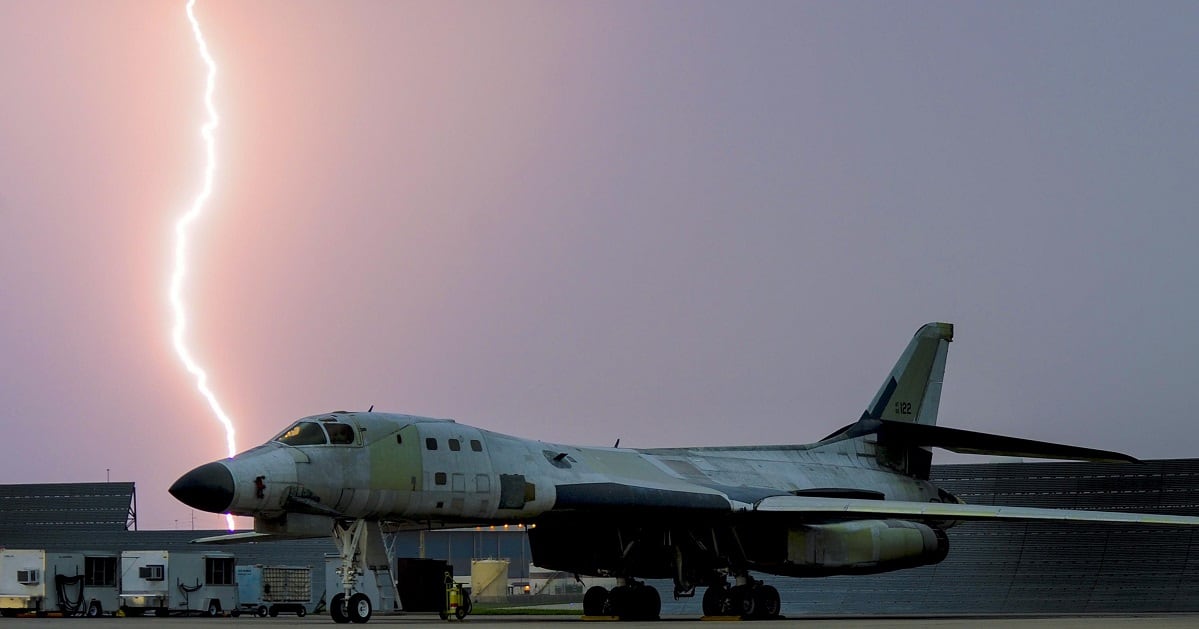The Air Force has, for the first time, flown a B-1B Lancer bomber with an inert cruise missile mounted externally.
And the Nov. 20 demonstration could pave the way for the Lancer to eventually carry hypersonic missiles mounted on an external pylon, the Air Force said in a release Tuesday.
The external captive carry flight, first reported by Military.com, took place at Edwards Air Force Base in California, and included a B-1 from the 412th Test Wing’s 419th Flight Test Squadron, part of the Global Power Combined Test Force.
The B-1 carried an inert Joint Air-to-Surface Standoff Missile, or JASSM, under an external pylon.
“Adapting a small number of our healthiest B-1s to carry hypersonic weapons is vital to bridge between the bomber force we have today, to the force of tomorrow,” said Gen. Tim Ray, the head of Air Force Global Strike Command, in the release. “This is a major step forward in our global precision fires capability and it is important we pursue these technologies to remain ahead of our competitors.”
Ray said that he hopes to modify a “limited number” of B-1s “to become the roving linebacker of the western Pacific and the North Atlantic.”
The B-1 has been plagued by maintenance troubles in recent years that have sidelined large portions of its fleet — and at times, grounded the Lancer fleet entirely. In August 2019, Vice Chairman of the Joint Chiefs of Staff Gen. John Hyten told lawmakers at his nomination hearing that only six of the Air Force’s 62 B-1s were mission capable at that time.
Hyten said then that repeated deployments had worn down the bombers and left dozens in depots for maintenance or otherwise down for other problems or inspections. The Air Force grounded the B-1 fleet in 2018 and again in 2019.
The Air Force has asked Congress for permission to retire 17 B-1s in 2021, though this demonstration will not change those plans.
RELATED

The B-1 will still be in compliance with the New Strategic Arms Reduction Treaty, or START, agreement, the Air Force said. The bomber was originally designed to have a moveable bulkhead and usable external hard points to carry nuclear weapons. But in 1994, the Lancer’s mission shifted to carrying just conventional weapons.
In 2007, with the START agreement, the B-1 began its physical conversion to conventional-only armaments. That conversion finished in 2011.
But this demonstration of an expanded carriage will allow the B-1 to carry conventional weapons with its external hard points and moveable bulkhead, while still following New START, the Air Force said.
Engineers from the Air Force Test Center, B-1 system program office and Boeing will now study the data from the Nov. 20 flight before moving on to the next phase: actually firing an externally mounted weapon.
“For us, we’re looking to do this safely, since this is the first time we will release a weapon from the external hard point in over 30 years,” project test lead Agustin Martinez said in the release. “So we pretty much focused on doing a safe build-up approach … to make sure the JASSM and the B-1 are communicating correctly [and ensure] once it does get released it will safely separate.”
The engineers will look at the data to make sure the weapon and pylon correctly integrated with the B-1. They will also look at the physical effects, software and flying qualities of the new shape on the bomber’s outer mold line.
The Air Force said last week’s flight followed multiple ground tests proving the B-1′s weapons capability could be expanded and reconfigured to carry larger-sized weapons both internally and externally. The first such test came last year, when the Air Force conducted an expanded carriage demonstration with a modified internal bomb bay and moveable bulkhead.
“We’re essentially displaying our external weapons carriage capability,” B-1 test pilot Maj. Bret Cunningham of the 419th Flight Test Squadron said in the release. “We have a JASSM weapon on what is traditionally the targeting pod pylon on the forward right hard point, so we are demonstrating that the B-1 has the capability to carry weapons and employ them externally.”
Beefing up the B-1′s weapons capability will allow two Lancer bombers to carry the equivalent of three bomber loads of weapons, the release said. This will benefit combatant commanders who are struggling to meet their mission requirements with a limited number of available bombers, the Air Force said.
Stephen Losey is the air warfare reporter for Defense News. He previously covered leadership and personnel issues at Air Force Times, and the Pentagon, special operations and air warfare at Military.com. He has traveled to the Middle East to cover U.S. Air Force operations.




